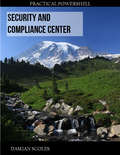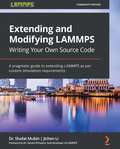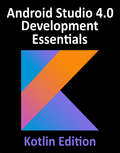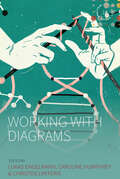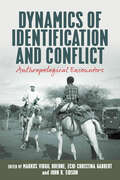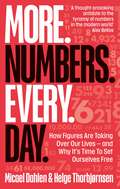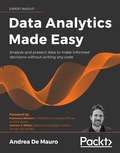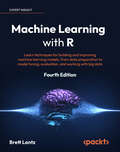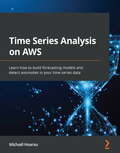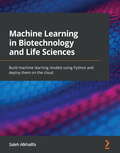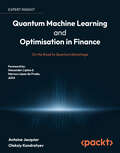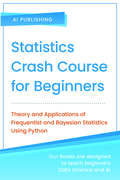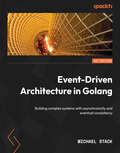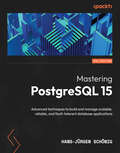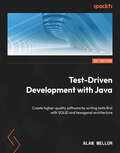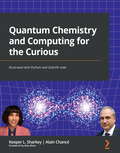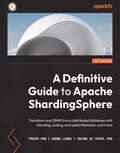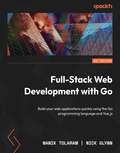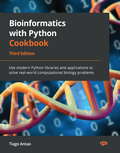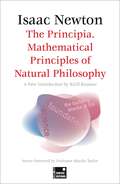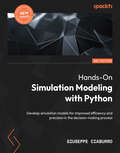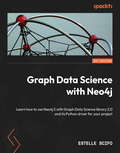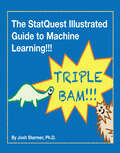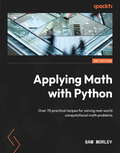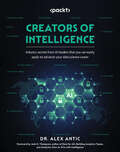- Table View
- List View
Practical PowerShell Security and Compliance Center: Get to grips with effectively managing the Security and Compliance Center with PowerShell, 2nd Edition
by Damian ScolesLearn all the latest practices to build and enhance your PowerShell scripts and manage the Security and Compliance Center easily and efficiently Key Features Gather the latest information and new cmdlets to get started with PowerShell Discover innovative ways to construct useful scripts Learn how to manage SCC with PowerShell through real-world scenarios Book Description PowerShell is an integral part of Office 365. This updated edition shares tips, tricks, new cmdlets, and best practices for using PowerShell with the Security and Compliance Center. The book starts by covering the basic tools of PowerShell, such as PowerShell ISE and PowerShell repositories, and then goes on to teach you how to connect to the SCC using multi-factor authentication. You will manage role groups to layer security, before exploring the importance of information barriers. As you progress, you will orchestrate insider risk policies to protect your organization from malicious users with access to sensitive data. Next, the book will show you how to manage various devices using tenant policies and device access rules. Later chapters will delve into various reporting methods and explore options for troubleshooting scripts and best practices to produce better scripts. The book concludes with an overview of Microsoft Secure Score to help you measure your organization's security posture. By the end of this book, you'll have the latest information and new cmdlets to confidently manage the Security and Compliance Center (SCC) with PowerShell. What you will learn Enhance the script, test it, and move it into production Make your PowerShell scripts more usable and accessible Study directory synchronization and its applications Explore layers of security that prevent unauthorized access Use PowerShell to implement Data Loss Prevention (DLP) Understand compliance and how it can be managed with PowerShell Who this book is for If you are already managing Exchange and have some PowerShell experience, then this book is for you. Professionals who want to gain more proficiency in PowerShell but are unsure of how to approach it will also find this book useful. To get the most out of this book, you must have sufficient experience of working in PowerShell as the book is not a beginner's guide to PowerShell.
Extending and Modifying LAMMPS Writing Your Own Source Code: A pragmatic guide to extending LAMMPS as per custom simulation requirements
by Dr. Shafat Mubin Jichen Li Dr. Steven PlimptonUnderstand the LAMMPS source code and modify it to meet your research needs, and run simulations for bespoke applications involving forces, thermostats, pair potentials and more with easeKey FeaturesUnderstand the structure of the LAMMPS source codeImplement custom features in the LAMMPS source code to meet your research needsRun example simulations involving forces, thermostats, and pair potentials based on implemented featuresBook DescriptionLAMMPS is one of the most widely used tools for running simulations for research in molecular dynamics. While the tool itself is fairly easy to use, more often than not you'll need to customize it to meet your specific simulation requirements. Extending and Modifying LAMMPS bridges this learning gap and helps you achieve this by writing custom code to add new features to LAMMPS source code. Written by ardent supporters of LAMMPS, this practical guide will enable you to extend the capabilities of LAMMPS with the help of step-by-step explanations of essential concepts, practical examples, and self-assessment questions. This LAMMPS book provides a hands-on approach to implementing associated methodologies that will get you up and running and productive in no time. You'll begin with a short introduction to the internal mechanisms of LAMMPS, and gradually transition to an overview of the source code along with a tutorial on modifying it. As you advance, you'll understand the structure, syntax, and organization of LAMMPS source code, and be able to write your own source code extensions to LAMMPS that implement features beyond the ones available in standard downloadable versions. By the end of this book, you'll have learned how to add your own extensions and modifications to the LAMMPS source code that can implement features that suit your simulation requirements.What you will learnIdentify how LAMMPS input script commands are parsed within the source codeUnderstand the architecture of the source codeRelate source code elements to simulated quantitiesLearn how stored quantities are accessed within the source codeExplore the mechanisms controlling pair styles, computes, and fixesModify the source code to implement custom features in LAMMPSWho this book is forThis book is for students, faculty members, and researchers who are currently using LAMMPS or considering switching to LAMMPS, have a basic knowledge of how to use LAMMPS, and are looking to extend LAMMPS source code for research purposes. This book is not a tutorial on using LAMMPS or writing LAMMPS scripts, and it is assumed that the reader is comfortable with the basic LAMMPS syntax. The book is geared toward users with little to no experience in source code editing. Familiarity with C++ programming is helpful but not necessary.
Android Studio 4.0 Development Essentials - Kotlin Edition: Build Android Apps with Android Studio 4.0 and Kotlin
by Neil SmythUpgrade your Android Studio skills and confidently create, test, and upload Android applications using KotlinKey FeaturesDiscover how to set up Android development and testing environmentsPractice object-oriented programming (OOP) in KotlinExplore all the major elements of Android JetpackBook DescriptionKotlin as an Android-compatible programming language is becoming increasingly popular. Fully updated for Android Studio 4.0, this book will teach you the skills necessary to develop Android-based applications using Kotlin.Starting with the basics, this book outlines the steps necessary to set up Android development and testing environments, and goes on to introduce you to programming in Kotlin. You'll practice Java to Kotlin code conversion and explore data types, operators, expressions, loops, functions, as well as the basics of OOP in Kotlin. You'll then learn about Android architecture components and advanced topics, such as intents, touchscreen handling, gesture recognition, multi-window support integration, and biometric authentication. As you make progress, you'll explore Android Studio 4.0's key features, including layout editor, direct reply notifications, and dynamic delivery. You'll also delve into Android Jetpack and create a sample app project using ViewModel, the Android Jetpack component. Finally, you will upload your app to Google Play Console and model the build process using Gradle.By the end of this Android book, you'll be fully prepared to develop applications using Android Studio 4.0 and Kotlin.What you will learnBuild Android apps by writing less error-prone code using KotlinReduce the amount of code using Android JetpackExplore unique ways of handling single and multi-touch eventsTrigger local and remote notifications on the deviceIntegrate biometric authentication into an Android appCreate, test, and upload an Android app bundle on Google Play StoreWho this book is forIf you are an application developer or programmer who wants to learn how to build reliable Android applications using Kotlin and Android Studio 4.0, then this book is for you. A basic understanding of programming languages and Android SDK is necessary.
Working With Diagrams (Studies in Social Analysis #14)
by Lukas Engelmann, Caroline Humphrey Christos LynterisArising from the need to go beyond the semiotic, cognitive, epistemic and symbolic reading of diagrams, this book looks at what diagrams are capable of in scholarly work related to the social sciences. Rather than attempting to define what diagrams are, and what their dietic capacity might be, contributions to this volume draw together the work diagrams do in the development of theories. Across a range of disciplines, the chapters introduce the ephemeral dimensions of scientist’s interactions and collaboration with diagrams, consider how diagrams configure cooperation across disciplines, and explore how diagrams have been made to work in ways that point beyond simplification, clarification and formalization.
Dynamics of Identification and Conflict: Anthropological Encounters
by Markus Virgil Hoehne, Echi Christina Gabbert, and John R. EidsonDealing with the dynamics of identification and conflict, this book uses theoretical orientations ranging from political ecology to rational choice theory, interpretive approaches, Marxism and multiscalar analysis. Case studies set in Africa, Europe and Central Asia are grouped in three sections devoted to pastoralism, identity and migration. What connects all of these anthropological explorations is a close focus on processes of identification and conflict at the level of particular actors in relation to the behaviour of large aggregates of people and to systemic conditions.
More. Numbers. Every. Day.: How Figures Are Taking Over Our Lives – And Why It's Time to Set Ourselves Free
by Micael Dahlen Helge ThorbjørnsenHow many steps have you done today?How many emails answered?How much money have you spent this week And how many hours have you slept?Welcome to the numberdemic, where a deluge of figures, stats and data manipulate your every move. From the way you work, date and exercise to the products you buy and the news you read, numbers have worked their way into every part of our lives. But is life better this way? How are all of those numbers affecting us?With fascinating, sometimes frightening and sometimes shrewdly funny research, behavioural economists Micael Dahlen and Helge Thorbjørnsen explain why we're so attached to numbers and how we can free ourselves from their tyranny. Along the way, you'll learn why viral videos, however inaccurate, become more convincing with every view; how numbers can affect the way we physically age, if we let them; why the more films you rate the less impressive you'll find them and how numbers that 'anchor' themselves in your brain can affect the size of your mortgage - plus much more.Sharp, insightful and totally engaging, MORE. NUMBERS. EVERY. DAY. is your vaccination against a world obsessed with numbers.'An entertaining and thought-provoking antidote to the tyranny of numbers in the modern world. By looking at the psychology of how we are tricked, goaded and often crushed by endless quantification, the authors present a winning case for weaning ourselves off number-dependence.'-Alex Bellos, author of Can You Solve My Problems?'Everybody should read this book. A smart and insightful read that will totally change the way you think - and live.'-Thomas Erikson, author of Sunday Times bestseller Surrounded By Idiots'Written in lucid, skillfully translated prose that puts the science into philosophical perspective, this shines a fascinating light on the modern-day obsession with numerical quantity over quality.' -Publishers Weekly'In 31,234 words Dahlen and Thorbjørnsen cast their four critical, and at times whimsical, eyes at our numbered existences revealing that consuming too much 'pi' might be bad for our health.'-Professor Scott Page, author of The Model Thinker
Data Analytics Made Easy: Use machine learning and data storytelling in your work without writing any code
by Andrea De Mauro Francesco Marzoni Andrew J. WalterMake informed decisions using data analytics, machine learning, and data visualizationsKey FeaturesTake raw data and transform it to add value to your organizationLearn the art of telling stories with your data to engage with your audienceApply machine learning algorithms to your data with a few clicks of a buttonBook DescriptionData analytics has become a necessity in modern business, and skills such as data visualization, machine learning, and digital storytelling are now essential in every field. If you want to make sense of your data and add value with informed decisions, this is the book for you. Data Analytics Made Easy is an accessible guide to help you start analyzing data and quickly apply these skills to your work. It focuses on how to generate insights from your data at the click of a few buttons, using the popular tools KNIME and Microsoft Power BI. The book introduces the concepts of data analytics and shows you how to get your data ready and apply machine learning algorithms. Implement a complete predictive analytics solution with KNIME and assess its level of accuracy. Create impressive visualizations with Microsoft Power BI and learn the greatest secret in successful analytics – how to tell a story with your data. You'll connect the dots on the various stages of the data-to-insights process and gain an overview of alternative tools, including Tableau and H20 Driverless AI. By the end of this book, you will have learned how to implement machine learning algorithms and sell the results to your customers without writing a line of code.What you will learnUnderstand the potential of data and its impact on any businessInfluence business decisions with effective data storytelling when delivering insightsUse KNIME to import, clean, transform, combine data feeds, and automate recurring workflowsLearn the basics of machine learning and AutoML to add value to your organizationBuild, test, and validate simple supervised and unsupervised machine learning models with KNIMEUse Power BI and Tableau to build professional-looking and business-centric visuals and dashboardsWho this book is forWhether you are working with data experts or want to find insights in your business' data, you'll find this book an effective way to add analytics to your skill stack.No previous math, statistics, or computer science knowledge is required.
Machine Learning with R: Learn techniques for building and improving machine learning models, from data preparation to model tuning, evaluation, and working with big data, 4th Edition
by Brett LantzLearn how to solve real-world data problems using machine learning and RPurchase of the print or Kindle book includes a free eBook in PDF format.Key FeaturesThe 10th Anniversary Edition of the bestselling R machine learning book, updated with 50% new content for R 4.0.0 and beyondHarness the power of R to build flexible, effective, and transparent machine learning modelsLearn quickly with this clear, hands-on guide by machine learning expert Brett LantzBook DescriptionMachine learning, at its core, is concerned with transforming data into actionable knowledge. R offers a powerful set of machine learning methods to quickly and easily gain insight from your data. Machine Learning with R, Fourth Edition, provides a hands-on, accessible, and readable guide to applying machine learning to real-world problems. Whether you are an experienced R user or new to the language, Brett Lantz teaches you everything you need to know for data pre-processing, uncovering key insights, making new predictions, and visualizing your findings. This 10th Anniversary Edition features several new chapters that reflect the progress of machine learning in the last few years and help you build your data science skills and tackle more challenging problems, including making successful machine learning models and advanced data preparation, building better learners, and making use of big data.You'll also find this classic R data science book updated to R 4.0.0 with newer and better libraries, advice on ethical and bias issues in machine learning, and an introduction to deep learning. Whether you're looking to take your first steps with R for machine learning or making sure your skills and knowledge are up to date, this is an unmissable read that will help you find powerful new insights in your data.What you will learnLearn the end-to-end process of machine learning from raw data to implementationClassify important outcomes using nearest neighbor and Bayesian methodsPredict future events using decision trees, rules, and support vector machinesForecast numeric data and estimate financial values using regression methodsModel complex processes with artificial neural networksPrepare, transform, and clean data using the tidyverseEvaluate your models and improve their performanceConnect R to SQL databases and emerging big data technologies such as Spark, Hadoop, H2O, and TensorFlowWho this book is forThis book is designed to help data scientists, actuaries, data analysts, financial analysts, social scientists, business and machine learning students, and any other practitioners who want a clear, accessible guide to machine learning with R. No R experience is required, although prior exposure to statistics and programming is helpful.
Time Series Analysis on AWS: Learn how to build forecasting models and detect anomalies in your time series data
by Michael HoarauLeverage AWS AI/ML managed services to generate value from your time series dataKey FeaturesSolve modern time series analysis problems such as forecasting and anomaly detectionGain a solid understanding of AWS AI/ML managed services and apply them to your business problemsExplore different algorithms to build applications that leverage time series dataBook DescriptionBeing a business analyst and data scientist, you have to use many algorithms and approaches to prepare, process, and build ML-based applications by leveraging time series data, but you face common problems, such as not knowing which algorithm to choose or how to combine and interpret them. Amazon Web Services (AWS) provides numerous services to help you build applications fueled by artificial intelligence (AI) capabilities. This book helps you get to grips with three AWS AI/ML-managed services to enable you to deliver your desired business outcomes.The book begins with Amazon Forecast, where you'll discover how to use time series forecasting, leveraging sophisticated statistical and machine learning algorithms to deliver business outcomes accurately. You'll then learn to use Amazon Lookout for Equipment to build multivariate time series anomaly detection models geared toward industrial equipment and understand how it provides valuable insights to reinforce teams focused on predictive maintenance and predictive quality use cases. In the last chapters, you'll explore Amazon Lookout for Metrics, and automatically detect and diagnose outliers in your business and operational data.By the end of this AWS book, you'll have understood how to use the three AWS AI services effectively to perform time series analysis.What you will learnUnderstand how time series data differs from other types of dataExplore the key challenges that can be solved using time series dataForecast future values of business metrics using Amazon ForecastDetect anomalies and deliver forewarnings using Lookout for EquipmentDetect anomalies in business metrics using Amazon Lookout for MetricsVisualize your predictions to reduce the time to extract insightsWho this book is forIf you're a data analyst, business analyst, or data scientist looking to analyze time series data effectively for solving business problems, this is the book for you. Basic statistics knowledge is assumed, but no machine learning knowledge is necessary. Prior experience with time series data and how it relates to various business problems will help you get the most out of this book. This guide will also help machine learning practitioners find new ways to leverage their skills to build effective time series-based applications.
Machine Learning in Biotechnology and Life Sciences: Build machine learning models using Python and deploy them on the cloud
by Saleh AlkhalifaExplore all the tools and templates needed for data scientists to drive success in their biotechnology careers with this comprehensive guideKey FeaturesLearn the applications of machine learning in biotechnology and life science sectorsDiscover exciting real-world applications of deep learning and natural language processingUnderstand the general process of deploying models to cloud platforms such as AWS and GCPBook DescriptionThe booming fields of biotechnology and life sciences have seen drastic changes over the last few years. With competition growing in every corner, companies around the globe are looking to data-driven methods such as machine learning to optimize processes and reduce costs. This book helps lab scientists, engineers, and managers to develop a data scientist's mindset by taking a hands-on approach to learning about the applications of machine learning to increase productivity and efficiency in no time.You'll start with a crash course in Python, SQL, and data science to develop and tune sophisticated models from scratch to automate processes and make predictions in the biotechnology and life sciences domain. As you advance, the book covers a number of advanced techniques in machine learning, deep learning, and natural language processing using real-world data.By the end of this machine learning book, you'll be able to build and deploy your own machine learning models to automate processes and make predictions using AWS and GCP.What you will learnGet started with Python programming and Structured Query Language (SQL)Develop a machine learning predictive model from scratch using PythonFine-tune deep learning models to optimize their performance for various tasksFind out how to deploy, evaluate, and monitor a model in the cloudUnderstand how to apply advanced techniques to real-world dataDiscover how to use key deep learning methods such as LSTMs and transformersWho this book is forThis book is for data scientists and scientific professionals looking to transcend to the biotechnology domain. Scientific professionals who are already established within the pharmaceutical and biotechnology sectors will find this book useful. A basic understanding of Python programming and beginner-level background in data science conjunction is needed to get the most out of this book.
Quantum Machine Learning and Optimisation in Finance: On the Road to Quantum Advantage
by Antoine Jacquier Alexander Lipton Oleksiy Kondratyev Marcos Lopez PradoLearn the principles of quantum machine learning and how to apply them in finance.Purchase of the print or Kindle book includes a free eBook in the PDF format.Key FeaturesDiscover how to solve optimisation problems on quantum computers that can provide a speedup edge over classical methodsUse methods of analogue and digital quantum computing to build powerful generative modelsCreate the latest algorithms that work on Noisy Intermediate-Scale Quantum (NISQ) computersBook DescriptionWith recent advances in quantum computing technology, we finally reached the era of Noisy Intermediate-Scale Quantum (NISQ) computing. NISQ-era quantum computers are powerful enough to test quantum computing algorithms and solve hard real-world problems faster than classical hardware.Speedup is so important in financial applications, ranging from analysing huge amounts of customer data to high frequency trading. This is where quantum computing can give you the edge. Quantum Machine Learning and Optimisation in Finance shows you how to create hybrid quantum-classical machine learning and optimisation models that can harness the power of NISQ hardware.This book will take you through the real-world productive applications of quantum computing. The book explores the main quantum computing algorithms implementable on existing NISQ devices and highlights a range of financial applications that can benefit from this new quantum computing paradigm.This book will help you be one of the first in the finance industry to use quantum machine learning models to solve classically hard real-world problems. We may have moved past the point of quantum computing supremacy, but our quest for establishing quantum computing advantage has just begun!What you will learnTrain parameterised quantum circuits as generative models that excel on NISQ hardwareSolve hard optimisation problemsApply quantum boosting to financial applicationsLearn how the variational quantum eigensolver and the quantum approximate optimisation algorithms workAnalyse the latest algorithms from quantum kernels to quantum semidefinite programmingApply quantum neural networks to credit approvalsWho this book is forThis book is for Quants and developers, data scientists, researchers, and students in quantitative finance. Although the focus is on financial use cases, all the methods and techniques are transferable to other areas.
Statistics Crash Course for Beginners: Theory and applications of Frequentist and Bayesian statistics using Python
by AI Sciences OUA beginner-friendly crash course to statistics utilizing Python with an eye to preparing students for further study in machine learningKey FeaturesA quick introduction to Python for statisticsHands-on projects for guided practiceInstant access to PDFs, Python codes, exercises, and references on the publisher's website at no extra costBook DescriptionData and statistics are the core subjects of Machine Learning (ML). The reality is that the average programmer may be tempted to view statistics with disinterest. But if you want to exploit the incredible power of ML, you need a thorough understanding of statistics. The reason is that a machine learning professional develops intelligent and fast algorithms that learn from data. This Statistics Crash Course for Beginners presents you with an easy way of learning statistics fast.Contrary to popular belief, statistics is no longer the exclusive domain of math PhDs. It's true that statistics deals with numbers and percentages. Hence, the subject can be very dry and boring. This book, however, transforms statistics into a fun subject.Frequentist and Bayesian statistics are two statistical techniques that interpret the concept of probability in different ways. Bayesian statistics was first introduced by Thomas Bayes in the 1770s. Bayesian statistics has been instrumental in the design of high-end algorithms that make accurate predictions. So, even after 250 years, the interest in Bayesian statistics has not faded. In fact, it has accelerated tremendously.Frequentist statistics is just as important as Bayesian statistics. In the statistical universe, Frequentist statistics is the most popular inferential technique. In fact, it's the first school of thought you come across when you enter the statistics world.By the end of this course, you will have built a solid foundation in statistical theory and practice that will prepare you for further study in machine learning and a career in programming. The code bundle for this course is available at https://www.aispublishing.net/nlp-crash-course1605125706681What you will learnGet a crash course in Python for statisticsUtilize Python to determine probability, random variables, and probability distributionsStudy descriptive statistics, measuring central tendency and spreadPerform exploratory analysis, such as data visualizationPractice statistical inference, frequentist inference, and Bayesian inferenceSuccessfully complete several real-world projectsWho this book is forThis course is intended for anyone interested in learning Frequentist and Bayesian statistics, either as a first step to machine learning or basic programming. No prior experience is required.
Event-Driven Architecture in Golang: Building complex systems with asynchronicity and eventual consistency
by Michael StackBegin building event-driven microservices, including patterns to handle data consistency and resiliencyKey FeaturesExplore the benefits and tradeoffs of event-driven architectures with practical examples and use casesUnderstand synergy with event sourcing, CQRS, and domain-driven development in software architectureBuild an end-to-end robust application architecture by the end of the bookBook DescriptionEvent-driven architecture in Golang is an approach used to develop applications that shares state changes asynchronously, internally, and externally using messages. EDA applications are better suited at handling situations that need to scale up quickly and the chances of individual component failures are less likely to bring your system crashing down. This is why EDA is a great thing to learn and this book is designed to get you started with the help of step-by-step explanations of essential concepts, practical examples, and more. You'll begin building event-driven microservices, including patterns to handle data consistency and resiliency. Not only will you learn the patterns behind event-driven microservices but also how to communicate using asynchronous messaging with event streams. You'll then build an application made of several microservices that communicates using both choreographed and orchestrated messaging. By the end of this book, you'll be able to build and deploy your own event-driven microservices using asynchronous communication.What you will learnUnderstand different event-driven patterns and best practicesPlan and design your software architecture with easeTrack changes and updates effectively using event sourcingTest and deploy your sample software application with easeMonitor and improve the performance of your software architectureWho this book is forThis hands-on book is for intermediate-level software architects, or senior software engineers working with Golang and interested in building asynchronous microservices using event sourcing, CQRS, and DDD. Intermediate-level knowledge of the Go syntax and concurrency features is necessary.
Mastering PostgreSQL 15: Advanced techniques to build and manage scalable, reliable, and fault-tolerant database applications, 5th Edition
by Hans-Jurgen SchonigMaster the capabilities of PostgreSQL 15 to efficiently administer and maintain your database.Purchase of the print or Kindle book includes a free PDF eBook.Key FeaturesUsing real world examples, get to grips with expert PostgreSQL 15 conceptsExplore performance improvement, database replication, data replication, database administration, and moreExtend PostgreSQL's functionalities to suit your organization's needs with minimal effortBook DescriptionStarting with an introduction to the newly released features of PostgreSQL 15, this updated fifth edition will help you get to grips with PostgreSQL administration and how to build dynamic database solutions for enterprise apps, including designing both physical and technical aspects of the system.You'll explore advanced PostgreSQL features, such as logical replication, database clusters, advanced indexing, and user management to manage and maintain your database. You'll then work with the PostgreSQL optimizer, configure PostgreSQL for high speed, and move from Oracle to PostgreSQL. Among the other skills that the book will help you build, you'll cover transactions, handling recursions, working with JSON and JSONB data, and setting up a Patroni cluster. It will show you how to improve performance with query optimization. You'll also focus on managing network security and work with backups and replication while exploring useful PostgreSQL extensions that optimize the performance of large databases.By the end of this PostgreSQL book, you'll be able to use your database to its utmost capacity by implementing advanced administrative tasks with ease.What you will learnMake use of the indexing features in PostgreSQL and fine-tune the performance of your queriesWork with stored procedures and manage backup and recoveryGet the hang of replication and failover techniquesImprove the security of your database server and handle encryption effectivelyTroubleshoot your PostgreSQL instance for solutions to common and not-so-common problemsPerform database migration from Oracle to PostgreSQL with easeWho this book is forThis database administration book is for PostgreSQL developers, database administrators, and professionals who want to implement advanced functionalities and master complex administrative tasks with PostgreSQL 15. Prior experience in PostgreSQL and familiarity with the basics of database administration will assist with understanding key concepts covered in the book.
Test-Driven Development with Java: Create higher-quality software by writing tests first with SOLID and hexagonal architecture
by Alan MellorDrive development with automated tests and gain the confidence you need to write high-quality softwareKey FeaturesGet up and running with common design patterns and TDD best practicesLearn to apply the rhythms of TDD – arrange, act, assert and red, green, refactorUnderstand the challenges of implementing TDD in the Java ecosystem and build a planBook DescriptionTest-driven development enables developers to craft well-designed code and prevent defects. It's a simple yet powerful tool that helps you focus on your code design, while automatically checking that your code works correctly. Mastering TDD will enable you to effectively utilize design patterns and become a proficient software architect.The book begins by explaining the basics of good code and bad code, bursting common myths, and why Test-driven development is crucial. You'll then gradually move toward building a sample application using TDD, where you'll apply the two key rhythms -- red, green, refactor and arrange, act, assert. Next, you'll learn how to bring external systems such as databases under control by using dependency inversion and test doubles. As you advance, you'll delve into advanced design techniques such as SOLID patterns, refactoring, and hexagonal architecture. You'll also balance your use of fast, repeatable unit tests against integration tests using the test pyramid as a guide. The concluding chapters will show you how to implement TDD in real-world use cases and scenarios and develop a modern REST microservice backed by a Postgres database in Java 17.By the end of this book, you'll be thinking differently about how you design code for simplicity and how correctness can be baked in as you go.What you will learnDiscover how to write effective test cases in JavaExplore how TDD can be incorporated into crafting softwareFind out how to write reusable and robust code in JavaUncover common myths about TDD and understand its effectivenessUnderstand the accurate rhythm of implementing TDDGet to grips with the process of refactoring and see how it affects the TDD processWho this book is forThis book is for expert Java developers and software architects crafting high-quality software in Java. Test-Driven Development with Java can be picked up by anyone with a strong working experience in Java who is planning to use Test-driven development for their upcoming projects.
Quantum Chemistry and Computing for the Curious: Illustrated with Python and Qiskit® code
by Keeper L. Sharkey Alain Chance Alex KhanAcquire knowledge of quantum chemistry concepts, the postulates of quantum mechanics, and the foundations of quantum computing, and execute illustrations made with Python code, Qiskit, and open-source quantum chemistry packagesKey FeaturesBe at the forefront of a quest for increased accuracy in chemistry applications and computingGet familiar with some open source quantum chemistry packages to run your own experimentsDevelop awareness of computational chemistry problems by using postulates of quantum mechanicsBook DescriptionExplore quantum chemical concepts and the postulates of quantum mechanics in a modern fashion, with the intent to see how chemistry and computing intertwine. Along the way you'll relate these concepts to quantum information theory and computation. We build a framework of computational tools that lead you through traditional computational methods and straight to the forefront of exciting opportunities. These opportunities will rely on achieving next-generation accuracy by going further than the standard approximations such as beyond Born-Oppenheimer calculations.Discover how leveraging quantum chemistry and computing is a key enabler for overcoming major challenges in the broader chemical industry. The skills that you will learn can be utilized to solve new-age business needs that specifically hinge on quantum chemistryWhat you will learnUnderstand mathematical properties of the building blocks of matterRun through the principles of quantum mechanics with illustrationsDesign quantum gate circuit computationsProgram in open-source chemistry software packages such as Qiskit®Execute state-of-the-art-chemistry calculations and simulationsRun companion Jupyter notebooks on the cloud with just a web browserExplain standard approximations in chemical simulationsWho this book is forProfessionals interested in chemistry and computer science at the early stages of learning, or interested in a career of quantum computational chemistry and quantum computing, including advanced high school and college students. Helpful to have high school level chemistry, mathematics (algebra), and programming. An introductory level of understanding Python is sufficient to read the code presented to illustrate quantum chemistry and computing
A Definitive Guide to Apache ShardingSphere: Transform any DBMS into a distributed database with sharding, scaling, encryption features, and more
by Trista Pan Zhang Liang Yacine Si TayebBecome well versed with all of ShardingSphere's features for every data management need with this comprehensive guide put together by ShardingSphere's founder and core contributorsKey FeaturesUnderstand the core concepts and efficiently set up Apache ShardingSphereEnhance existing databases with sharding, elastic scaling, encryption, governance features, and moreImport and customize the ecosystem's core features for various application scenariosBook DescriptionApache ShardingSphere is a new open source ecosystem for distributed data infrastructures based on pluggability and cloud-native principles that helps enhance your database.This book begins with a quick overview of the main challenges faced by database management systems (DBMSs) in production environments, followed by a brief introduction to the software's kernel concept. After that, using real-world examples of distributed database solutions, elastic scaling, DistSQL, synthetic monitoring, database gateways, and SQL authority and user authentication, you'll fully understand ShardingSphere's architectural components, how they're configured and can be plugged into your existing infrastructure, and how to manage your data and applications. You'll also explore ShardingSphere-JDBC and ShardingSphere-Proxy, the ecosystem's clients, and how they can work either concurrently or independently to address your needs. You'll then learn how to customize the plugin platform to define personalized user strategies and manage multiple configurations seamlessly. Finally, the book enables you to get up and running with functional and performance tests for all scenarios.By the end of this book, you'll be able to build and deploy a customized version of ShardingSphere, addressing the key pain points encountered in your data management infrastructure.What you will learnAssemble a custom solution using the software's pluggable architectureDiscover how to use Database Plus features effectivelyUnderstand the difference between ShardingSphere-JDBC and ShardingSphere-ProxyGet to grips with ShardingSphere's pluggability mechanismExplore mainstream test models for databases and distributed databasesPerform migrations from an on-premise database to a cloud-based databaseReconfigure your data infrastructure and eliminate switching costsWho this book is forThis book is for database administrators working with distributed database solutions who are looking to explore the capabilities of Apache ShardingSphere. DBAs looking for more capable, flexible, and cost-effective alternatives to the solutions they're currently utilizing will also find this book helpful. To get started with this book, a basic understanding of, or even an interest in, databases, relational databases, SQL languages, cloud computing, and data management in general is needed.
Full-Stack Web Development with Go: Build your web applications quickly using the Go programming language and Vue.js
by Nanik Tolaram Nick GlynnA Go programmer's hands-on guide to go from building basic server-side templates to full single page apps using Tailwind CSS, Vue.js, and moreKey FeaturesLearn how to structure your Go projects, be smarter with SQLc, create middleware and secure your appsExplore different frontend frameworks and dive into Vue and Tailwind CSSUse Terraform and Docker and deploy in minutesBook DescriptionGo is a modern programming language with capabilities to enable high-performance app development. With its growing web framework ecosystem, Go is a preferred choice for building complete web apps. This practical guide will enable you to take your Go skills to the next level building full stack apps.This book walks you through creating and developing a complete modern web service from auth, middleware, server-side rendering, databases, and modern frontend frameworks and Go-powered APIs. You'll start by structuring the app and important aspects such as networking, before integrating all the different parts together to build a complete web product. Next, you'll learn how to build and ship a complete product by starting with the fundamental building blocks of creating a Go backend. You'll apply best practices for cookies, APIs, and security, and level up your skills with the fastest growing frontend framework, Vue. Once your full stack application is ready, you'll understand how to push the app to production and be prepared to serve customers and share it with the world.By the end of this book, you'll have learned how to build and ship secure, scalable, and complete products and how to combine Golang with existing products using best practices.What you will learnDiscover how to quickly scaffold, structure, and build your Golang applicationsDesign and build databases using PostgreSQL and SQLc to generate type-safe SQL codeMonitor applications with centralized logging and metrics collection for high performanceExplore frontend frameworks and libraries such as Vuetify, Buefy, and Tailwind CSS to build a responsive frontend for your appCommunicate securely between the frontend and backend with cookies and session handling with middlewareUnderstand how to package applications using Docker and set up CI pipelines in GitHubWho this book is forThis book is for Go programmers who want to combine the power of the Go language with modern web development technologies to build complete web apps from frontend to backend. The book assumes beginner-level knowledge of HTML, CSS, and the web.
Bioinformatics with Python Cookbook: Use modern Python libraries and applications to solve real-world computational biology problems, 3rd Edition
by Tiago AntaoDiscover modern, next-generation sequencing libraries from the powerful Python ecosystem to perform cutting-edge research and analyze large amounts of biological dataKey FeaturesPerform complex bioinformatics analysis using the most essential Python libraries and applicationsImplement next-generation sequencing, metagenomics, automating analysis, population genetics, and much moreExplore various statistical and machine learning techniques for bioinformatics data analysisBook DescriptionBioinformatics is an active research field that uses a range of simple-to-advanced computations to extract valuable information from biological data, and this book will show you how to manage these tasks using Python.This updated third edition of the Bioinformatics with Python Cookbook begins with a quick overview of the various tools and libraries in the Python ecosystem that will help you convert, analyze, and visualize biological datasets. Next, you'll cover key techniques for next-generation sequencing, single-cell analysis, genomics, metagenomics, population genetics, phylogenetics, and proteomics with the help of real-world examples. You'll learn how to work with important pipeline systems, such as Galaxy servers and Snakemake, and understand the various modules in Python for functional and asynchronous programming. This book will also help you explore topics such as SNP discovery using statistical approaches under high-performance computing frameworks, including Dask and Spark. In addition to this, you'll explore the application of machine learning algorithms in bioinformatics.By the end of this bioinformatics Python book, you'll be equipped with the knowledge you need to implement the latest programming techniques and frameworks, empowering you to deal with bioinformatics data on every scale.What you will learnBecome well-versed with data processing libraries such as NumPy, pandas, arrow, and zarr in the context of bioinformatic analysisInteract with genomic databasesSolve real-world problems in the fields of population genetics, phylogenetics, and proteomicsBuild bioinformatics pipelines using a Galaxy server and SnakemakeWork with functools and itertools for functional programmingPerform parallel processing with Dask on biological dataExplore principal component analysis (PCA) techniques with scikit-learnWho this book is forThis book is for bioinformatics analysts, data scientists, computational biologists, researchers, and Python developers who want to address intermediate-to-advanced biological and bioinformatics problems. Working knowledge of the Python programming language is expected. Basic knowledge of biology will also be helpful.
The Principia. Mathematical Principles of Natural Philosophy (Foundations)
by Sir Isaac Newton Professor Marika TaylorNewton's bold masterwork helped shaped the cultural landscape of the world today. Now in a digestible, pocket format for the modern reader.New concise edition with a new introduction, abridged for the modern reader. The Principia. Mathematical Principles of Natural Philosophy is one of the most important scientific works ever to have been written and has had a profound impact on modern science. Consisting of three separate books, the Principia states Newton&’s laws of motion and Newton&’s law of universal gravitation. Understanding and acceptance of these theories was not immediate, however by the end of the seventeenth century no one could deny that Newton had far exceeded all previous works and revolutionised scientific thinking.The FLAME TREE Foundations series features core publications which together have shaped the cultural landscape of the modern world, with cutting-edge research distilled into pocket guides designed to be both accessible and informative.
Hands-On Simulation Modeling with Python: Develop simulation models for improved efficiency and precision in the decision-making process, 2nd Edition
by Giuseppe CiaburroLearn to construct state-of-the-art simulation models with Python and enhance your simulation modelling skills, as well as create and analyze digital prototypes of physical models with easeKey FeaturesUnderstand various statistical and physical simulations to improve systems using PythonLearn to create the numerical prototype of a real model using hands-on examplesEvaluate performance and output results based on how the prototype would work in the real worldBook DescriptionSimulation modelling is an exploration method that aims to imitate physical systems in a virtual environment and retrieve useful statistical inferences from it. The ability to analyze the model as it runs sets simulation modelling apart from other methods used in conventional analyses. This book is your comprehensive and hands-on guide to understanding various computational statistical simulations using Python. The book begins by helping you get familiarized with the fundamental concepts of simulation modelling, that'll enable you to understand the various methods and techniques needed to explore complex topics. Data scientists working with simulation models will be able to put their knowledge to work with this practical guide. As you advance, you'll dive deep into numerical simulation algorithms, including an overview of relevant applications, with the help of real-world use cases and practical examples. You'll also find out how to use Python to develop simulation models and how to use several Python packages. Finally, you'll get to grips with various numerical simulation algorithms and concepts, such as Markov Decision Processes, Monte Carlo methods, and bootstrapping techniques.By the end of this book, you'll have learned how to construct and deploy simulation models of your own to overcome real-world challenges.What you will learnGet to grips with the concept of randomness and the data generation processDelve into resampling methodsDiscover how to work with Monte Carlo simulationsUtilize simulations to improve or optimize systemsFind out how to run efficient simulations to analyze real-world systemsUnderstand how to simulate random walks using Markov chainsWho this book is forThis book is for data scientists, simulation engineers, and anyone who is already familiar with the basic computational methods and wants to implement various simulation techniques such as Monte-Carlo methods and statistical simulation using Python.
Graph Data Science with Neo4j: Learn how to use Neo4j 5 with Graph Data Science library 2.0 and its Python driver for your project
by Estelle ScifoSupercharge your data with the limitless potential of Neo4j 5, the premier graph database for cutting-edge machine learningPurchase of the print or Kindle book includes a free PDF eBookKey FeaturesExtract meaningful information from graph data with Neo4j's latest version 5Use Graph Algorithms into a regular Machine Learning pipeline in PythonLearn the core principles of the Graph Data Science Library to make predictions and create data science pipelines.Book DescriptionNeo4j, along with its Graph Data Science (GDS) library, is a complete solution to store, query, and analyze graph data. As graph databases are getting more popular among developers, data scientists are likely to face such databases in their career, making it an indispensable skill to work with graph algorithms for extracting context information and improving the overall model prediction performance.Data scientists working with Python will be able to put their knowledge to work with this practical guide to Neo4j and the GDS library that offers step-by-step explanations of essential concepts and practical instructions for implementing data science techniques on graph data using the latest Neo4j version 5 and its associated libraries. You'll start by querying Neo4j with Cypher and learn how to characterize graph datasets. As you get the hang of running graph algorithms on graph data stored into Neo4j, you'll understand the new and advanced capabilities of the GDS library that enable you to make predictions and write data science pipelines. Using the newly released GDSL Python driver, you'll be able to integrate graph algorithms into your ML pipeline.By the end of this book, you'll be able to take advantage of the relationships in your dataset to improve your current model and make other types of elaborate predictions.What you will learnUse the Cypher query language to query graph databases such as Neo4jBuild graph datasets from your own data and public knowledge graphsMake graph-specific predictions such as link predictionExplore the latest version of Neo4j to build a graph data science pipelineRun a scikit-learn prediction algorithm with graph dataTrain a predictive embedding algorithm in GDS and manage the model storeWho this book is forIf you're a data scientist or data professional with a foundation in the basics of Neo4j and are now ready to understand how to build advanced analytics solutions, you'll find this graph data science book useful. Familiarity with the major components of a data science project in Python and Neo4j is necessary to follow the concepts covered in this book.
The StatQuest Illustrated Guide to Machine Learning!!!: Master the concepts, one full-color picture at a time, from the basics all the way to neural networks. BAM!
by Josh Starmer PhDWith over 300 pages of easy to follow, step-by-step illustrations, everyone can understand Machine Learning from the basics to advanced topics like neural networksKey FeaturesFully illustrated in color and written in the style of a graphic novel. BAM!Every concept is taught with a very gentle learning curve. DOUBLE BAM!!Every page is labeled as Main Ideas or Details, and you can focus on one, or the other, or both. TRIPLE BAM!!!Book DescriptionMachine Learning is awesome and powerful, but it can also appear incredibly complicated. That's where The StatQuest Illustrated Guide to Machine Learning comes in. This book takes the machine learning algorithms, no matter how complicated, and breaks them down into small, bite-sized pieces that are easy to understand. Each concept is clearly illustrated to provide you, the reader, with an intuition about how the methods work that goes beyond the equations alone. The StatQuest Illustrated Guide does not dumb down the concepts. Instead, it builds you up so that you are smarter and have a deeper understanding of Machine Learning.The StatQuest Illustrated Guide to Machine Learning starts with the basics, showing you what machine learning is and what are its goals, and builds on those, one picture at a time, until you have mastered the concepts behind self driving cars and facial recognition.What you will learnMaster the fundamentals to use, optimize and evaluate machine learningDevelop an intuition for fundamental statistics conceptsApply Statistical distributions, R-squared, p-values to your ML modelsGain deep insight into the building blocks like Gradient DescentVisualize machine learning methods, including Neural NetworksLearn about the limitations of machine learningWho this book is forThe StatQuest Illustrated Guide To Machine Learning is a great starting point for anyone who wants to get into the field of Machine Learning. It also serves as the perfect reference for seasoned practitioners who need to review key concepts for an upcoming job interview.For beginners, the illustrations and step-by-step approach ensure that the learning curve is as gentle as possible.For experts, the depth each topic is explored and the visualizations ensure “I finally understand!” moments occur in each chapter.
Applying Math with Python: Over 70 practical recipes for solving real-world computational math problems, 2nd Edition
by Sam MorleyDiscover easy-to-follow solutions and techniques to help you to implement applied mathematical concepts such as probability, calculus, and equations using Python's numeric and scientific librariesKey FeaturesCompute complex mathematical problems using programming logic with the help of step-by-step recipesLearn how to use Python libraries for computation, mathematical modeling, and statisticsDiscover simple yet effective techniques for solving mathematical equations and apply them in real-world statisticsBook DescriptionThe updated edition of Applying Math with Python will help you solve complex problems in a wide variety of mathematical fields in simple and efficient ways. Old recipes have been revised for new libraries and several recipes have been added to demonstrate new tools such as JAX.You'll start by refreshing your knowledge of several core mathematical fields and learn about packages covered in Python's scientific stack, including NumPy, SciPy, and Matplotlib. As you progress, you'll gradually get to grips with more advanced topics of calculus, probability, and networks (graph theory). Once you've developed a solid base in these topics, you'll have the confidence to set out on math adventures with Python as you explore Python's applications in data science and statistics, forecasting, geometry, and optimization. The final chapters will take you through a collection of miscellaneous problems, including working with specific data formats and accelerating code.By the end of this book, you'll have an arsenal of practical coding solutions that can be used and modified to solve a wide range of practical problems in computational mathematics and data science.What you will learnBecome familiar with basic Python packages, tools, and libraries for solving mathematical problemsExplore real-world applications of mathematics to reduce a problem in optimizationUnderstand the core concepts of applied mathematics and their application in computer scienceFind out how to choose the most suitable package, tool, or technique to solve a problemImplement basic mathematical plotting, change plot styles, and add labels to plots using MatplotlibGet to grips with probability theory with the Bayesian inference and Markov Chain Monte Carlo (MCMC) methodsWho this book is forWhether you are a professional programmer or a student looking to solve mathematical problems computationally using Python, this is the book for you. Advanced mathematics proficiency is not a prerequisite, but basic knowledge of mathematics will help you to get the most out of this Python math book. Familiarity with the concepts of data structures in Python is assumed.
Creators of Intelligence: Industry secrets from AI leaders that you can easily apply to advance your data science career
by John K. Thompson Dr. Alex AnticGet your hands on the secret recipe for a rewarding career in data science from 18 AI leadersPurchase of the print or Kindle book includes a free PDF eBookKey FeaturesGain access to insights and expertise from data science leaders shared in one-on-one interviewsGet pragmatic advice on how to become a successful data scientist and data science leaderReceive guidance to overcome common pitfalls and challenges and ensure your projects' successBook DescriptionA Gartner prediction in 2018 led to numerous articles stating that "85% of AI and machine learning projects fail to deliver.” Although it's unclear whether a mass extinction event occurred for AI implementations at the end of 2022, the question remains: how can I ensure that my project delivers value and doesn't become a statistic? The demand for data scientists has only grown since 2015, when they were dubbed the new “rock stars” of business. But how can you become a data science rock star? As a new senior data leader, how can you build and manage a productive team? And what is the path to becoming a chief data officer? Creators of Intelligence is a collection of in-depth, one-on-one interviews where Dr. Alex Antic, a recognized data science leader, explores the answers to these questions and more with some of the world's leading data science leaders and CDOs. Interviews with: Cortnie Abercrombie, Edward Santow, Kshira Saagar, Charles Martin, Petar Velickovic, Kathleen Maley, Kirk Borne, Nikolaj Van Omme, Jason Tamara Widjaja, Jon Whittle, Althea Davis, Igor Halperin, Christina Stathopoulos, Angshuman Ghosh, Maria Milosavljevic, Dr. Meri Rosich, Dat Tran, and Stephane Doyen.What you will learnFind out where to start with AI ethics and how to evolve from frameworks to practiceDiscover tips on building and managing a data science teamReceive advice for organizations seeking to build or mature a data science capabilityStop beating your head against a brick wall – pick the environment that'll support your successRead stories from successful data leaders as they reflect on the successes and failures in data strategy developmentUnderstand how business areas can best work with data science teams to drive business valueWho this book is forThis book is for a wide range of audience, from people working in the data science industry through to data science leaders and chief data officers. This book will also cater to senior business leaders interested in learning how data and analytics are used to support decision-making in different domains and sectors. Students contemplating a career in artificial intelligence (AI) and the broader data sector will also find this book useful, along with anyone developing and delivering university-level education, including undergraduate, postgraduate, and executive programs.
